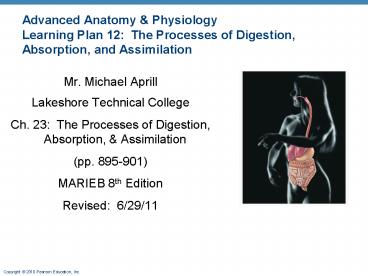Mr. Michael Aprill PowerPoint PPT Presentation
1 / 14
Title: Mr. Michael Aprill
1
Advanced Anatomy PhysiologyLearning Plan 12
The Processes of Digestion, Absorption, and
Assimilation
- Mr. Michael Aprill
- Lakeshore Technical College
- Ch. 23 The Processes of Digestion, Absorption,
Assimilation - (pp. 895-901)
- MARIEB 8th Edition
- Revised 6/29/11
2
PART 3 PHYSIOLOGY OF CHEMICAL DIGESTION
ABSORPTIONIntro (pp. 895-897 Figs. 23.32-23.34
- Chemical digestion is a catabolic process in
which large food molecules are broken down to
chemical building blocks (monomers), which are
small enough to be absorbed by the GI tract
lining. - Chemical digestion is accomplished by enzymes,
secreted by intrinsic and accessory glands of the
alimentary canal, used in hydrolysis reactions.
3
PART 3 PHYSIOLOGY OF CHEMICAL DIGESTION
ABSORPTIONCarbohydrates (pp. 895-897 Figs.
23.32-23.34
- Carbohydrates
- Monosaccharides are simple sugars that are
absorbed immediately (glucose, galactose, and
fructose). - Disaccharides are composed of two monosaccharides
bonded together (maltose, lactose, and sucrose). - The digestible polysaccharide found in the diet
is starch other polysaccharides, such as
cellulose, are not able to be broken down by
humans. - Chemical digestion of carbohydrates begins in the
mouth, where salivary amylase breaks large
polysaccharides into smaller fragments.
4
(No Transcript)
5
PART 3 PHYSIOLOGY OF CHEMICAL DIGESTION
ABSORPTIONProteins (pp. 895-897 Figs.
23.32-23.34
- Proteins digested into amino acids in the GI
tract include not only dietary proteins but also
enzyme proteins secreted into the GI tract lumen. - Pepsin, secreted by the chief cells, begins the
chemical digestion of proteins in the stomach. - Rennin is produced in infants and breaks down
milk proteins. - Pancreatic enzymes, such as trypsin and
chymotrypsin, further break down proteins in the
small intestine. - The brush border enzymes carboxypeptidase,
aminopeptidase, and dipeptidase work on freeing
single amino acids in the small intestine.
6
(No Transcript)
7
(No Transcript)
8
PART 3 PHYSIOLOGY OF CHEMICAL DIGESTION
ABSORPTIONLipids
- The small intestine is the sole site for lipid
digestion. - Lipases are secreted by the pancreas and are the
enzymes that digest fats after they have been
pretreated with bile.
9
(No Transcript)
10
PART 3 PHYSIOLOGY OF CHEMICAL DIGESTION
ABSORPTIONNucleic Acids
- Nucleic acids (both DNA and RNA) are hydrolyzed
to their nucleotide monomers by pancreatic
nucleases present in pancreatic juice.
11
ABSORPTION--Intro (pp. 898-901 Fig. 23.34)
- Absorption occurs along the entire length of the
small intestine, and most of it is completed
before the chyme reaches the ileum (pp. 898901
Fig. 23.34).
12
ABSORPTIONSpecial Nutrients (pp. 898-901 Fig.
23.34)
- Absorption of Specific Nutrients
- Glucose and galactose are transported into the
epithelial cells by common protein carriers and
are then moved by facilitated diffusion into the
capillary blood. - Several types of carriers transport the different
amino acids before entering the capillary blood
by diffusion. - Monoglycerides and free fatty acids of lipid
digestion become associated with bile salts and
lecithin to form micelles, which are necessary
for lipid absorption.
13
ABSORPTIONSpecial Nutrients (pp. 898-901 Fig.
23.34)
- Absorption of Specific Nutrients
- Pentose sugars, nitrogenous bases, and phosphate
ions are transported actively across the
epithelium by special transport carriers in the
villus epithelium. - The small intestine absorbs dietary vitamins,
while the large intestine absorbs vitamins B and
K. - Electrolytes
- actively absorbed along the entire length of the
small intestine - except for calcium and iron, which are absorbed
in the duodenum. - Water is the most abundant substance in chyme and
95 of it is absorbed in the small intestine by
osmosis.
14
ABSORPTIONMalabsorption (pp. 898-901 Fig. 23.34)
- Malabsorption of nutrients can result from
anything that interferes with the delivery of
bile or pancreatic juices, as well as factors
that damage the intestinal mucosa.

